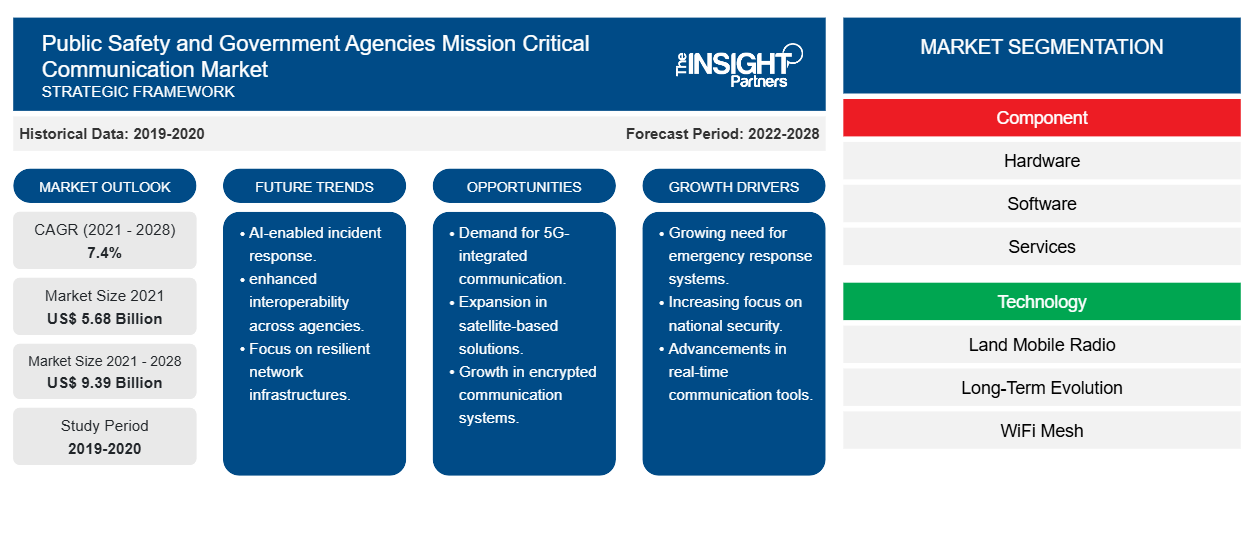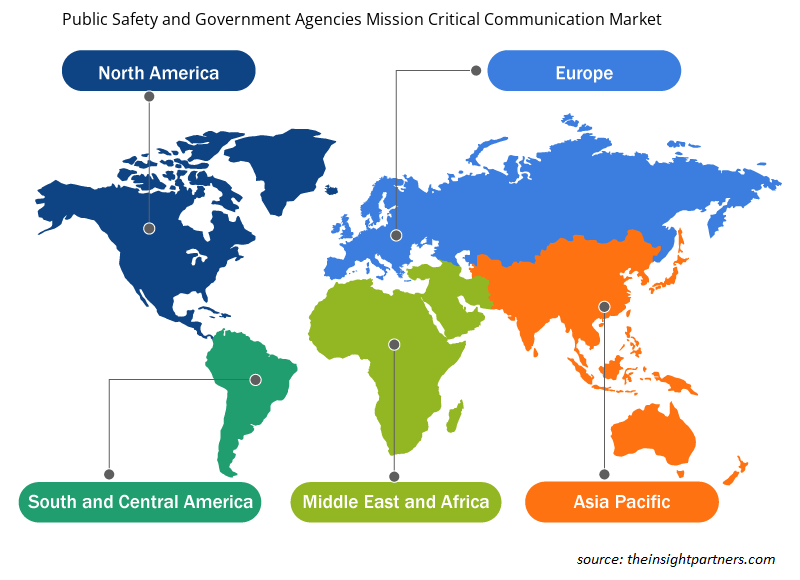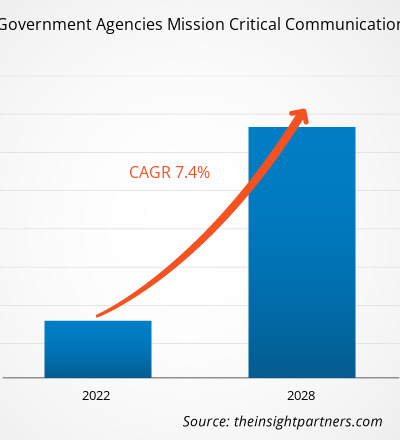Der Markt für unternehmenskritische Kommunikation für öffentliche Sicherheit und Regierungsbehörden wurde im Jahr 2021 auf 5.684,3 Millionen US-Dollar geschätzt und soll bis 2028 9.390,0 Millionen US-Dollar erreichen; es wird erwartet, dass er von 2021 bis 2028 mit einer durchschnittlichen jährlichen Wachstumsrate von 7,4 % wächst.
Eine unternehmenskritische Kommunikation umfasst Lösungen, die Kommunikationsmethoden für Endbenutzer in Situationen unterstützen, in denen herkömmliche Systeme ihre Anforderungen nicht erfüllen. Außerdem erleichtert der Markt für unternehmenskritische Kommunikation für öffentliche Sicherheit und Regierungsbehörden die Kommunikation und unterstützt Operationen, die mit Gefahren für Menschen und Eigentum verbunden sind. Wichtige Kommunikationsgeräte werden verwendet, um Menschen über kritische Situationen aufzuklären. Auf dem Markt für unternehmenskritische Kommunikation für öffentliche Sicherheit und Regierungsbehörden konzentrieren sich die Netzwerkbetreiber auf neue Design- und Managementstrategien für die Kommunikationsinfrastruktur, um auf die schnelle Entwicklung von Netzwerken und Diensten zu reagieren und einen zuverlässigen Netzwerkbetrieb zu gewährleisten.
Auswirkungen der COVID-19-Pandemie auf den Markt für unternehmenskritische Kommunikation für öffentliche Sicherheit und Regierungsbehörden
Die COVID-19-Epidemie hatte erhebliche Auswirkungen auf den Markt für unternehmenskritische Kommunikation für öffentliche Sicherheit und Regierungsbehörden in Nordamerika, was zu erheblichen finanziellen Verlusten für die Endverbrauchsindustrien führte und sie dazu zwang, ihre MCX-Implementierungspläne noch weiter zu verschieben. Die Epidemie wirkte sich auch auf die Betriebsabläufe an den Hardware-Produktionsstandorten für den Markt für unternehmenskritische Kommunikation für öffentliche Sicherheit und Regierungsbehörden aus und erforderte einen kurzen Stillstand. Infolgedessen reduzierten mehrere bedeutende Komponentenlieferanten und Technologieanbieter Kosten und Produktion. Da die Nachfrage nach Elektronik konstant blieb, verhalf dies dem Markt zu einem erneuten Wachstum.
Passen Sie diesen Bericht Ihren Anforderungen an
Sie erhalten kostenlos individuelle Anpassungen an jedem Bericht, einschließlich Teilen dieses Berichts oder einer Analyse auf Länderebene, eines Excel-Datenpakets sowie tolle Angebote und Rabatte für Start-ups und Universitäten.
Markt für unternehmenskritische Kommunikation für öffentliche Sicherheit und Regierungsbehörden: Strategische Einblicke

-
Holen Sie sich die wichtigsten Markttrends aus diesem Bericht.Dieses KOSTENLOSE Beispiel umfasst eine Datenanalyse von Markttrends bis hin zu Schätzungen und Prognosen.
Markteinblicke
Steigende Nachfrage von verschiedenen Regierungsbehörden treibt das Wachstum des Marktes für unternehmenskritische Kommunikation für öffentliche Sicherheit und Regierungsbehörden voran
Die Bürger erwarten von Regierungsbehörden einen Service und eine Kommunikation rund um die Uhr. Sie wünschen sich einen einfachen Zugang zu korrekten, aktuellen Informationen und eine reibungslose Verbindung mit den zuständigen Regierungsbeamten. Sie möchten auch, dass Dienstleistungen schnell, effektiv und transparent erbracht und Probleme schnell, effektiv und offen gelöst werden. Viele Regierungsbehörden verlassen sich immer noch auf veraltete Kommunikationsinfrastrukturen wie gemietete PBX-Systeme oder Systeme vom Typ Centrex. Auch auf dem Markt für unternehmenskritische Kommunikation für öffentliche Sicherheit und Regierungsbehörden entwickeln und pflegen Regierungen hervorragende Kommunikationssysteme, um im öffentlichen Raum respektable Akteure zu sein. Die oben genannten Faktoren ermöglichen es ihnen, die Bedürfnisse und Vorlieben der Bürger einzuschätzen und eine deliberative öffentliche Arena für die Beteiligung mehrerer Interessengruppen, fundierte politische Debatten und die Wirksamkeit der Notfallentwicklung zu fördern. All diese Aspekte treiben die Nachfrage nach unternehmenskritischer Kommunikation für öffentliche Sicherheit und Regierungsbehörden voran.
Komponentenbasierte Markteinblicke
Zu den Hardwarekomponenten des Marktes für unternehmenskritische Kommunikation für öffentliche Sicherheit und Regierungsbehörden gehören Kommando- und Kontrollzentren, Router und Gateways sowie Verteilungsmanagementsysteme. Der Einsatz von Hardwarekomponenten variiert je nach Art der öffentlichen Sicherheitsbehörde. Die steigende Zahl der weltweit gemeldeten Verbrechen treibt die Nachfrage nach unternehmenskritischer Kommunikation für öffentliche Sicherheit und Regierungsbehörden an.
Technologiebasierte Markteinblicke
Land Mobile Radio (LMR), auch Zweiwegefunk genannt, ist eine der am häufigsten verwendeten Kommunikationstechnologien im Markt für missionskritische Kommunikation der öffentlichen Sicherheit und von Regierungsbehörden. Die Technologie wird kontinuierlich getestet und verbessert und gilt als Maßstab für den Erfolg kritischer Kommunikation, insbesondere im Bereich der öffentlichen Sicherheit.
Auf dem Markt für unternehmenskritische Kommunikation für öffentliche Sicherheit und Regierungsbehörden ist die Produktentwicklung die häufig von Unternehmen verfolgte Strategie, ihr Produktportfolio zu erweitern, was ihnen hilft, ihren Kundenstamm zu vergrößern und ihren Markennamen zu wahren. Einige der jüngsten Schlüsselentwicklungen auf dem Markt sind wie folgt:
- Im Jahr 2021 setzte die Regierung der Republik Indonesien 500 Iridium Push-to-Talk (PTT)-Geräte ein, die von Iridium Communications Inc. beschafft wurden, um den Kommunikationsbetrieb im ganzen Land zu verbessern. Die indonesische Regierung verfügt nun über eine zuverlässige „Grab-and-go“-Echtzeit-Satellitenkommunikationslösung, die für die mobile Kommunikation in den zahlreichen Insellandschaften des Landes geeignet ist.
- Im Jahr 2021 bestätigte Inmarsat, dass BSNL, sein strategischer Partner in Indien, die erforderlichen Lizenzen für die Bereitstellung der erstklassigen mobilen Breitbanddienste Global Xpress (GX) von Inmarsat erhalten hat. GX wird indischen Kunden in den Bereichen Regierung, Luftfahrt und Schifffahrt im Rahmen der Inflight and Maritime Connectivity (IFMC)-Lizenz von BSNL des Ministeriums für Telekommunikation zur Verfügung gestellt.
Regionale Einblicke in den Markt für unternehmenskritische Kommunikation für öffentliche Sicherheit und Regierungsbehörden
Die regionalen Trends und Faktoren, die den Markt für unternehmenskritische Kommunikation für öffentliche Sicherheit und Regierungsbehörden während des gesamten Prognosezeitraums beeinflussen, wurden von den Analysten von Insight Partners ausführlich erläutert. In diesem Abschnitt werden auch die Marktsegmente und die Geografie für unternehmenskritische Kommunikation für öffentliche Sicherheit und Regierungsbehörden in Nordamerika, Europa, im asiatisch-pazifischen Raum, im Nahen Osten und Afrika sowie in Süd- und Mittelamerika erörtert.

- Erhalten Sie regionale Daten für den Markt für unternehmenskritische Kommunikation für öffentliche Sicherheit und Regierungsbehörden
Umfang des Marktberichts für unternehmenskritische Kommunikation für öffentliche Sicherheit und Regierungsbehörden
| Berichtsattribut | Details |
|---|---|
| Marktgröße im Jahr 2021 | 5,68 Milliarden US-Dollar |
| Marktgröße bis 2028 | 9,39 Milliarden US-Dollar |
| Globale CAGR (2021 - 2028) | 7,4 % |
| Historische Daten | 2019-2020 |
| Prognosezeitraum | 2022–2028 |
| Abgedeckte Segmente |
Nach Komponente
|
| Abgedeckte Regionen und Länder |
Nordamerika
|
| Marktführer und wichtige Unternehmensprofile |
|
Dichte der Marktteilnehmer für unternehmenskritische Kommunikation für öffentliche Sicherheit und Regierungsbehörden: Auswirkungen auf die Geschäftsdynamik verstehen
Der Markt für unternehmenskritische Kommunikation für öffentliche Sicherheit und Regierungsbehörden wächst rasant. Dies wird durch die steigende Nachfrage der Endnutzer aufgrund von Faktoren wie sich entwickelnden Verbraucherpräferenzen, technologischen Fortschritten und einem größeren Bewusstsein für die Vorteile des Produkts vorangetrieben. Mit der steigenden Nachfrage erweitern Unternehmen ihr Angebot, entwickeln Innovationen, um die Bedürfnisse der Verbraucher zu erfüllen, und nutzen neue Trends, was das Marktwachstum weiter ankurbelt.
Die Marktteilnehmerdichte bezieht sich auf die Verteilung von Firmen oder Unternehmen, die in einem bestimmten Markt oder einer bestimmten Branche tätig sind. Sie gibt an, wie viele Wettbewerber (Marktteilnehmer) in einem bestimmten Marktraum im Verhältnis zu seiner Größe oder seinem gesamten Marktwert präsent sind.
Die wichtigsten Unternehmen, die auf dem Markt für unternehmenskritische Kommunikation für öffentliche Sicherheit und Regierungsbehörden tätig sind, sind:
- Ascom Holding AG (Ascom)
- Globalstar
- Inmarsat Global Limited
- Iridium Communications Inc.
- nbn co ltd.
Haftungsausschluss : Die oben aufgeführten Unternehmen sind nicht in einer bestimmten Reihenfolge aufgeführt.

- Überblick über die wichtigsten Akteure auf dem Markt für missionskritische Kommunikation für öffentliche Sicherheit und Regierungsbehörden
Marktsegmentierung für unternehmenskritische Kommunikation für öffentliche Sicherheit und Regierungsbehörden:
Nach Komponente
- Hardware
- Software
Nach Technologie
- Long-Term Evolution (LTE)
- Land Mobile Radio (LMR)
- WLAN Mesh
Firmenprofile
- Ascom Holding AG (Ascom)
- Globalstar
- Inmarsat Global Limited
- Iridium Communications Inc.
- nbn co ltd.
- SES SA
- Telesat
- Thuraya Telekommunikationsunternehmen
- AT&T Inc.
- SPACEX
- Historische Analyse (2 Jahre), Basisjahr, Prognose (7 Jahre) mit CAGR
- PEST- und SWOT-Analyse
- Marktgröße Wert/Volumen – Global, Regional, Land
- Branchen- und Wettbewerbslandschaft
- Excel-Datensatz
Aktuelle Berichte
Erfahrungsberichte
Grund zum Kauf
- Fundierte Entscheidungsfindung
- Marktdynamik verstehen
- Wettbewerbsanalyse
- Kundeneinblicke
- Marktprognosen
- Risikominimierung
- Strategische Planung
- Investitionsbegründung
- Identifizierung neuer Märkte
- Verbesserung von Marketingstrategien
- Steigerung der Betriebseffizienz
- Anpassung an regulatorische Trends






















 Kostenlose Probe anfordern für - Markt für missionskritische Kommunikation für öffentliche Sicherheit und Regierungsbehörden
Kostenlose Probe anfordern für - Markt für missionskritische Kommunikation für öffentliche Sicherheit und Regierungsbehörden